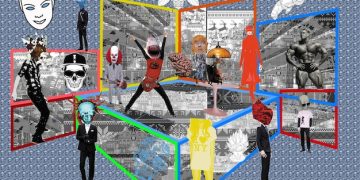From Page to Screen: A Deep Dive into Comic Book Film Adaptations

From Page to Screen explores the intricate process of adapting comic books into film, analyzing the challenges and successes in translating iconic characters and stories to a visual medium, while examining the impact of these adaptations on both the comic book and film industries.
The world of cinema and comic books have become increasingly intertwined. The journey From Page to Screen: Analyzing the Adaptation of Comic Books into Film is filled with challenges, triumphs, and the constant pursuit of capturing the essence of beloved characters and storylines for a global audience.
The Evolution of Comic Book Adaptations
Comic book adaptations have gone through a significant transformation over the decades. Initially, these adaptations were often campy and low-budget. However, the introduction of special effects revolutionized the landscape, allowing filmmakers to bring truly complex and fantastical stories to life.
The evolution from campy to cinematic marvels isn’t just about technology; it represents a shift in how Hollywood perceives comic books. No longer seen as niche entertainment, comic book properties are now considered to be valuable intellectual property.
Early Adaptations: A Start of Something New
Early adaptations such as the Superman serials in the 1940s and Batman in the 1960s were notable for their limited budgets and often simplistic storytelling. These adaptations, while groundbreaking for their time, prioritized accessibility over fidelity to the source material.
The Impact of Special Effects
The introduction of sophisticated special effects in movies like “Superman” (1978) and “Batman” (1989) allowed filmmakers to depict characters with superpowers and create visually intricate environments that were previously impossible to realize on screen. This technological leap was instrumental in bringing comic book heroes to life in a more believable and captivating way.
- Visual Fidelity: Special effects allow for greater faithfulness to the visual style of comic books.
- Expanded Storytelling: More complex narratives become feasible with enhanced visual tools.
- Audience Engagement: Better effects lead to more immersive and engaging viewing experiences.
The use of special effects has also led to increased expectations from audiences. As technology advances, so does the demand for increasingly realistic and spectacular visuals.
The Challenges of Adaptation
Adapting comic books for the screen is not without its difficulties. Filmmakers must balance remaining true to the source material with the need to make the story accessible and engaging for a broader audience. This balancing act requires careful consideration when it comes to character portrayals, plot points, and overall tone.
One of the biggest challenges is satisfying the diverse expectations of comic book fans while attracting a mainstream audience unfamiliar with the source material. Compromises are often necessary, and these can sometimes lead to controversy and disappointment among fans.

Character Portrayal
Bringing iconic comic book characters to life on screen requires more than just casting the right actors. It involves understanding the core essence of these characters and finding ways to convey their personalities, motivations, and internal conflicts through performance, dialogue, and visual representation.
Plot and Narrative Structure
Comic book stories are often complex and span multiple issues, arcs, and even decades. Condensing these intricate narratives into a two- or three-hour movie requires careful editing and streamlining. Plot points may need to be altered, characters may be omitted, and storylines may be simplified to fit the cinematic format.
- Streamlining Complex Plots: Condensing sprawling storylines for a movie is a delicate process.
- Character Omission: Removing characters to focus the narrative can upset fans.
- Balancing Fan Expectations: Satisfying both die-hard fans and casual viewers is essential.
These narrative adaptations need to strike a balance, ensuring that they don’t alienate longtime fans while still providing a coherent and engaging experience for viewers unfamiliar with the original comic books.

Success Stories: Capturing the Essence
Despite the challenges, many comic book adaptations have achieved critical and commercial success. These successful adaptations share a common thread: they understand and respect the source material while also making smart choices about how to translate it to the screen.
Successful adaptations often involve filmmakers who are genuinely passionate about the source material. This passion translates into a willingness to go the extra mile to ensure that the movie captures the spirit and tone of the comic book.
Case Study: “Spider-Man: Into the Spider-Verse”
“Spider-Man: Into the Spider-Verse” is an excellent example of a comic book adaptation that not only embraced the source material but also pushed the boundaries of what a superhero movie could be. The film’s unique animation style, diverse cast of characters, and inventive storytelling earned widespread acclaim and demonstrated that comic book adaptations could be fresh, innovative, and true to their roots.
Case Study: “The Dark Knight”
“The Dark Knight” is a masterpiece that successfully translated the dark, gritty, and philosophical themes of Batman comics to the big screen. Christopher Nolan’s approach to the character and his world was grounded in realism, and the movie’s complex plot and memorable performances made it a critical and commercial triumph.
- Respect for Source Material: Understanding and valuing what makes the comic special.
- Creative Interpretation: Innovating while staying true to the core elements.
- Strong Storytelling: Crafting a narrative that resonates with a wide audience.
By focusing on the emotional depth of the characters and by exploring moral complexities, these movies have resonated with audiences and proved that comic book adaptations can be more than just simple action movies.
The Business Side of Adaptations
The adaptation of comic books into film is big business. These adaptations have become tentpole releases for major studios, often generating billions of dollars in revenue. The success of these movies has led to increased investment in the genre, with studios constantly seeking out new comic book properties to exploit.
The financial incentives for adapting comic books are immense. Not only do these movies generate revenue at the box office, but they also drive sales of merchandise, comic books, and other related products. Additionally, successful franchises can spawn sequels, spin-offs, and even entire cinematic universes.
The Role of Cinematic Universes
The success of the Marvel Cinematic Universe (MCU) has demonstrated the potential for creating interconnected universes of comic book movies. This approach allows studios to tell larger, more complex stories that span multiple films and characters, creating a sense of investment and anticipation among audiences.
Impact on the Comic Book Industry
The popularity of comic book movies has had a significant impact on the comic book industry itself. Increased exposure has led to more readership, higher sales, and a greater appreciation for the medium. Many comic book creators have also found new opportunities to work in film and television, bringing their unique perspectives and skills to the adaptation process.
- Increased Investment: Major studios are pouring more resources into comic book adaptations.
- Revenue Streams: Movies drive sales of merchandise, comics, and related products.
- Cross-Promotion: Films boost the popularity and sales of the original comic books.
The symbiotic relationship between comic books and film has created a thriving ecosystem where both industries benefit from the other’s success.
Evolving Trends in Comic Book Adaptations
As the comic book adaptation landscape continues to evolve, several trends have emerged that are shaping the future of the genre. These trends include a greater emphasis on diversity and representation, a willingness to take risks with unconventional storytelling approaches, and a focus on creating more authentic and nuanced character portrayals.
One of the most exciting trends is the increasing diversity in comic book adaptations. Studios are recognizing the importance of representing a broader range of voices and perspectives on screen, and they are actively seeking out stories that reflect the diversity of the modern world.
Focus on Diversity and Representation
The push for greater diversity and representation in comic book movies is not just a matter of social responsibility; it’s also a smart business decision. By appealing to a wider audience, studios can increase their potential revenue and create movies that are more relevant and resonant.
Experimentation with Storytelling
Filmmakers are also experimenting with new and unconventional storytelling approaches in comic book adaptations. Movies like “Deadpool” and “Guardians of the Galaxy” have demonstrated that audiences are willing to embrace movies that break the mold and offer a fresh take on the superhero genre.
- Diverse Casting: More inclusive representation on screen.
- Unconventional Stories: Taking risks with unique narratives.
- Authentic Characters: Nuanced portrayals that resonate with audiences.
This willingness to experiment and innovate is a sign that the comic book adaptation genre is far from running out of steam. Instead, it is constantly reinventing itself and finding new ways to surprise and delight audiences.
The Future of From Page to Screen
The future of comic book adaptations looks bright. With advancements in technology, a growing appreciation for the source material, and a willingness to take creative risks, the genre has the potential to reach new heights. The ongoing evolution of From Page to Screen: Analyzing the Adaptation of Comic Books into Film promises exciting developments.
As technology continues to advance, filmmakers will have access to even more powerful tools for bringing comic book stories to life on screen. Virtual reality, augmented reality, and other immersive technologies could revolutionize the way audiences experience these movies, creating a sense of presence and engagement that was previously unimaginable.
Technological Advancements
Advancements in VFX will allow for increasingly faithful and spectacular representations of comic book characters and worlds. Filmmakers will be able to create visually stunning movies that push the boundaries of what’s possible on screen.
Creative Risks
The willingness to take creative risks with storytelling, character portrayals, and genre conventions will lead to movies that are fresh, innovative, and surprising. This could include exploring mature themes, experimenting with different tones and styles, and challenging audience expectations.
- Immersive Experiences: Virtual and augmented reality enhancing viewing.
- Groundbreaking VFX: Increasingly realistic and spectacular visual effects.
- Diverse Narratives: A wider range of stories and perspectives explored.
The fusion of technology, creativity, and a deep understanding of the source material will drive the next generation of comic book adaptations and keep audiences coming back for more.
| Key Point | Brief Description |
|---|---|
| 🎬 Early Adaptations | Initial adaptations were often simplistic, focusing on accessibility over fidelity. |
| 🌟 Special Effects | Introduction of VFX allowed filmmakers to depict complex stories believably. |
| 💸 Business Impact | Adaptations are massive revenue generators, influencing the comic industry. |
| 🔮 Future Trends | Expect more diversity, innovative storytelling, and immersive technologies. |
Frequently Asked Questions
▼
A successful adaptation respects the source material while making smart choices for the screen, balancing the needs of both hardcore fans and general audiences, creating something amazing for all levels of Geek Lifestyle.
▼
Challenges include condensing complex plots, satisfying diverse fan expectations, and staying true to the unique visual style of comic books, while also appealing to a broader audience.
▼
Special effects have revolutionized these adaptations, enabling filmmakers to bring fantastical characters and worlds to life, creating a more immersive and visually stunning experience for viewers, that the average viewer does not always know.
▼
Cinematic universes have become increasingly popular, allowing studios to tell larger, interconnected stories across multiple films, creating a sense of investment and anticipation among audiences, that expands the Geek lifestyle.
▼
We can expect to see increased diversity and representation, more experimentation with unconventional storytelling, and greater use of immersive technologies like virtual and augmented reality, for a better experience for all fans.
Conclusion
The journey from page to screen is a continuous process of adaptation, innovation, and dedication to preserving the essence of beloved comic book stories. As technology evolves and creative boundaries are pushed, the future of comic book adaptations promises even more exciting and immersive experiences for fans worldwide.





